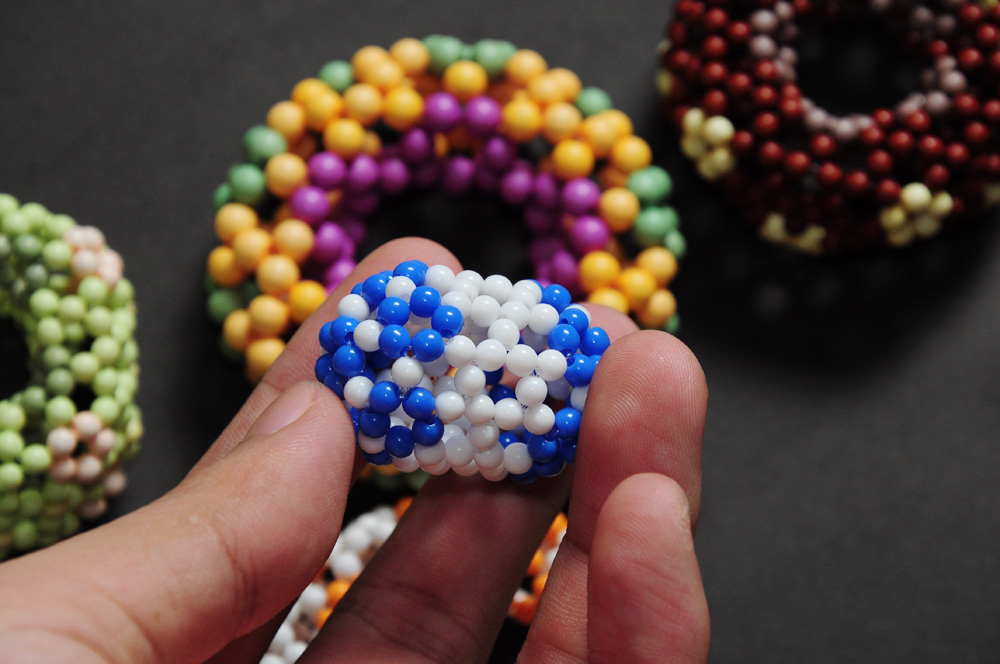
Monday, June 28, 2010
A dodecahedral ball made with bamboo
Again, I saw this interesting dodecahedral ball in Alberto's living room. He told me that he bought this at Vietnam a few years ago.


Sunday, June 27, 2010
M.C Escher's "going up the stairs"
Thursday, June 24, 2010
Wednesday, June 16, 2010
Tuesday, June 15, 2010
Another 2x2x2 P-type triply periodic minimal surface
Beaded Zongzi
Tomorrow is the Duanwu Festival (端午節), also known as Dragon Boat Festival, a traditional and statutory holiday in China. We eat Zongzi (粽子) during this Festival. Zonzi is a traditional Chinese food, made of glutinous rice stuffed with different fillings and wrapped in bamboo or reed leaves. The shape of zongzi ranges from being relatively tetrahedral in southern China (including Taiwan) to cylindrical in northern China.
It is not a bad idea to make bead model of zonzi. Since there are 12 pentagons in a cage-like fullerene, one has to put three pentagons around each vertex of a tetrahedron.
[Strange, this post disappear automatically.]
Thursday, June 10, 2010
【科學工藝】化學家用珠珠串出富勒烯家族 Scientific Crafting: Chemists Construct Fullerenes with Beads
The blog of Case (Case Press) has written something about us in Chinese.
Here are a few photos taken by the photographer (張譽鐘) of Case (Center for the Advancement of Science Education), National Taiwan University.


 (High-genus fullerene with octagonal necks, No:3)
(High-genus fullerene with octagonal necks, No:3)

Here are a few photos taken by the photographer (張譽鐘) of Case (Center for the Advancement of Science Education), National Taiwan University.


 (High-genus fullerene with octagonal necks, No:3)
(High-genus fullerene with octagonal necks, No:3)

The Bead Model of Sierpinski Tetrahedron
Wednesday, June 9, 2010
More toroidal carbon nanotubes (TCNTs)
Tuesday, June 8, 2010
Math Monday: Mathematical Beading
The fullerene structures that we have created have been featured in Math Monday for the Make Magazine blog.
Math Monday, written by George Hart, is a weekly column in a partnership between the Museum of Mathematics and Make Magazine. This column discusses fun, experiential, puzzling topics in mathematics.

Math Monday, written by George Hart, is a weekly column in a partnership between the Museum of Mathematics and Make Magazine. This column discusses fun, experiential, puzzling topics in mathematics.

Beaded Fullerenes: 3D Molecular Structures
The blog "The Beading Gem's Journal " has featured the 3D molecular structures that we have constructed. :-)


Saturday, June 5, 2010
Friday, June 4, 2010
2x2x2 bead model of Schoen's I-WP surface
Chern Chuang (莊宸) created this amazing graphitic structures consisting of a Schoen's I-WP surface decorated with graphene sheet. The I-WP surface, found by Schoen in 1970, is a TPMS of cubic symmetry Im3m. In addition to I-WP surface, there are other TPMSs of Im3m symmetry, such as Schwartz P and Neovius surfaces.
Chuang figured out the systematic structural rule for this kind of periodic minimal surface at the beginning of this year. Based on his post, I constructed a 1x1x1 bead model for this structure using three different colors of beads. Apparently, he seems to find time to bead even in the army. Now we have this beautiful 2x2x2 bead model created with 5mm semi-transparent plastic beads. Based on the previous post by Chuang, there are 3456 carbon atoms in the structure. So one need about 5000 beads to create it. It is quite a work.
I am kind of surprised by the strong mechanical strength of this structure. Unlike bead models for other minimal surfaces including Schwartz P or D surfaces, this model seems to be quite rigid, and a little bit like that of a brick. So, it may not be a bad idea to have this kind of 2x2x2 I-WP surface as a high-strength but low-density brick for purpose of construction. The only problem is that it is quite difficult to create even just one of this kind of bricks. We may solve the problem if we can invent a robot to weave them automatically.



The 2x2x2 I-WP surface and my friend's iPad:

Chuang figured out the systematic structural rule for this kind of periodic minimal surface at the beginning of this year. Based on his post, I constructed a 1x1x1 bead model for this structure using three different colors of beads. Apparently, he seems to find time to bead even in the army. Now we have this beautiful 2x2x2 bead model created with 5mm semi-transparent plastic beads. Based on the previous post by Chuang, there are 3456 carbon atoms in the structure. So one need about 5000 beads to create it. It is quite a work.
I am kind of surprised by the strong mechanical strength of this structure. Unlike bead models for other minimal surfaces including Schwartz P or D surfaces, this model seems to be quite rigid, and a little bit like that of a brick. So, it may not be a bad idea to have this kind of 2x2x2 I-WP surface as a high-strength but low-density brick for purpose of construction. The only problem is that it is quite difficult to create even just one of this kind of bricks. We may solve the problem if we can invent a robot to weave them automatically.



The 2x2x2 I-WP surface and my friend's iPad:

IWP Surface with 2-by-2-by-2 Unit Cells
This is the beaded molecule, or beaded solid, that I brought to Taipei yesterday, one with 3,456 carbon atoms.
Labels:
Extended Structures,
hyperbolic,
I-WP surface,
Periodic Minimial Surfaces,
Schwarzite,
Simulation
Subscribe to:
Posts (Atom)

























